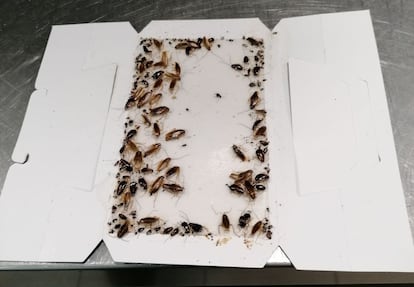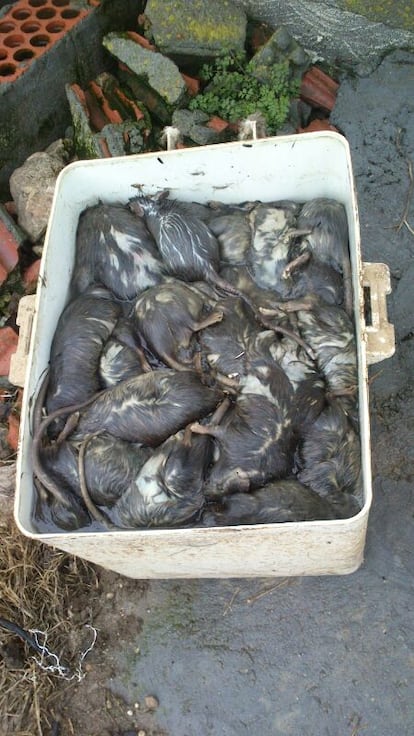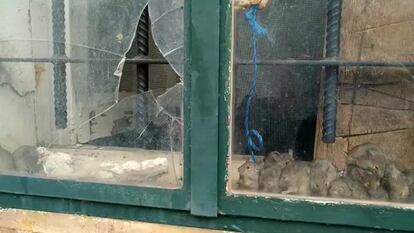‘Rats the size of cats’ and plagues of roaches: How a warm autumn can spark a pest psychosis
Unusually high temperatures create ideal conditions for rodent and insect infestations. In Spain, residents of big cities have been calling fumigation services in record numbers. Some experts are blaming climate change


Nancy Berrocal, a florist in the Tirso de Molina neighborhood in downtown Madrid, points an accusing finger at the flower beds. Until 15 days ago, they were overgrown and full of garbage: a perfect home for hundreds of cockroaches and rats. “They removed the bushes and fumigated. Cockroaches and rats came out in a stream, the workers were kicking them,” she recalls. Berrocal explains that this autumn, pests have been proliferating day and night: “Cockroaches continue to come out when it gets dark; they go to the terraces [of the bars and cafés] looking for food.” A neighbor, Marcelo Casas, says that “the rats were right at home” and fears that they will return “as soon as garbage accumulates again.” In San Cristóbal de los Ángeles, a neighborhood in the south of Madrid, Adela Crespo says “there are rats as big as cats” in the buildings. “There are holes in which they nest and they come out as soon as night falls.”
Madrid is not an isolated case. According to EZSA, one of the largest companies in the pest control sector, there was an “unprecedented increase in calls” throughout the country in October about pests in homes, businesses and restaurants. In general, 2022 has been “atypical,” says Ignacio Santamarta, EZSA’s director of innovation. In 2021, the company received 17,284 calls; so far in 2022, there have been 28,518, representing a 60% increase. “There has been very high incidence. I have never seen increases like this before,” he says.
Jorge Galván, director of the National Association of Environmental Health Companies (Anecpla), which represents 85% of businesses in the sector, also confirms this fall has seen a sharp rise in infestations, “totally anomalous for the season,” but Anecpla does not have a national study with data from its 566 associates. Galván notes that the EZSA figures are reliable, but biased and not extrapolated, as they only measure the activity of a single company.
Santamarta says the number of callouts to deal with cockroaches in October was 58.2% higher in Spain compared to the same month in 2021, particularly in the large cities: 70.1% in Madrid, 59.4% in Valencia, 55% in Barcelona, 47.4% in Málaga and 45.6% in Seville. Accumulated data for 2022 points to a 65% rise nationwide compared to last year.
The number of calls due to rat infestations also shot up by 52.1% on average – 63.1% in Madrid, 62.8% in Barcelona, 49.4% in Valencia, 48.9% in Seville and 42.7% in Malaga – with accumulated increases of 71% on average. In Valencia, the worst outbreak occurred in La Fuensanta, a neighborhood of 3,700 inhabitants in a social housing area that was built after the flood of 1957. “They are in the sewers and sneak into the houses through the vents at ground level. They also climb trees and from there, get into the apartments. The neighborhood is very worried,” says a resident.
Rodent census
In Barcelona, a TiKTok video showing dozens of rodents in the main Plaça de Catalunya square triggered widespread psychosis in July. After it went viral, the City Council covered the area with rat poison, which succeeded in reducing their numbers. By August, the Barcelona Public Health Agency announced that the situation was under control. Barcelona was the first city in Spain to conduct a municipal rodent census, in 2018, which concluded there were 259,000 rodents in the city, one for every six residents. The Barcelona health authorities also acknowledge that complaints about cockroaches soared between May and October. So far this year, there have been 1,000, compared to 800 in 2021, which forced a 44% increase in the pest control budget and a 51% rise in the number of prevention teams in the street to 47 people in total.
In Madrid, city officials deny that there are more cockroaches now than at any other time. A spokesman for Madrid Salud, the agency in charge of pest control, says that “data for October is similar to 2018-2022 period” and that there has been a “downward trend” in calls about the insects in recent years. However, Madrid Salud clarified that its findings refer to the two species of sewer cockroach – the black or Oriental and the American – and not the German cockroach, which is the species that most often affects homes and premises and the one that the EZSA data is based on. “Sewage cockroaches have a very strong seasonality in Madrid and most of the warnings occur between May and the beginning of August,” adds the spokesman. “At the end of fall they are residual.” Asked whether there has been an increase in rodents, Madrid Salud provided no answer.
@melbranda Plaza cataluña de noche 🐭 #viral #rat #mouse #fypシ #barcelona #denoche #españa #viajebarcelona
♬ Terror - Sounds M
But it’s not just rats and cockroaches. “There has also been an increase in flying insect warnings, although less so,” says EZSA. In September, these increased by 35% in Madrid and in October, by 24%. The second figure is “surprising,” says EZSA, because these insects are more typical of the summer. In October and November, notes Santamarta, “there have been reports of bites from tiger mosquitoes and black flies in Spain, at a time when they should be dormant.”
EZSA, Anecpla and various city councils consulted by this newspapers attributed this proliferation to meteorological causes: the combination of high temperatures and a lack of rain. According to the Spanish Meteorological Agency, October had the highest average temperature since data started to be collected in 1961, surpassing the previous record by almost one degree Celsius. The average temperature was 18° degrees Celsius, 3.6° above the normal average, making October “the most abnormally warm month in Spain” since records began. In addition, rainfall was only two thirds of normal levels. From January to October, 2022 has been the warmest year since 1961 and the fourth-driest.
Although cockroaches and rats are present all year round, Santamarta and Galván explain that this fall the “ideal conditions” have been in place for their spread. In higher temperatures, their reproductive cycles are shortened, so they reproduce more often and for longer, while their larvae and offspring have greater chances of survival. A lack of rain allows cockroaches to live unhindered in the sewer manholes, “as they are drier and there is no water drag.” The same is true of rodents. Rising temperatures also cause them to colonize new habitats where previously the cold kept them at bay. Another factor is that “we have come out of a pandemic,” during which the human presence was reduced and they “gained a lot of ground.” To exacerbate the situation, control and elimination efforts were reduced during the coronavirus lockdowns.

For Galván, climate change is the main culprit. “We used to have a subtropical climate, but we are getting closer and closer to a tropical one,” he says, which in turn increases the populations of problematic species and attracts new ones. Rising temperatures are accompanied by other factors, such as changes in migratory movements, globalization and increased tourism. “Spain has a staggering potential as a transmitter of zoonotic diseases; in less than 36 hours you can be anywhere on the planet, less time than it takes for a virus to develop.”
Entomologist Rubén Bueno cites more causes, such as resistance to biocides, which reduces their effectiveness. These pests are not only a nuisance, but represent transmission of diseases, all sources consulted warn. Cockroaches can carry salmonellosis, infectious hepatitis, leprosy, bubonic plague and dysentery, while rats can spread rabies, leptospirosis, plague and typhus, in addition to having fleas and ticks.
Sign up for our weekly newsletter to get more English-language news coverage from EL PAÍS USA Edition
Tu suscripción se está usando en otro dispositivo
¿Quieres añadir otro usuario a tu suscripción?
Si continúas leyendo en este dispositivo, no se podrá leer en el otro.
FlechaTu suscripción se está usando en otro dispositivo y solo puedes acceder a EL PAÍS desde un dispositivo a la vez.
Si quieres compartir tu cuenta, cambia tu suscripción a la modalidad Premium, así podrás añadir otro usuario. Cada uno accederá con su propia cuenta de email, lo que os permitirá personalizar vuestra experiencia en EL PAÍS.
¿Tienes una suscripción de empresa? Accede aquí para contratar más cuentas.
En el caso de no saber quién está usando tu cuenta, te recomendamos cambiar tu contraseña aquí.
Si decides continuar compartiendo tu cuenta, este mensaje se mostrará en tu dispositivo y en el de la otra persona que está usando tu cuenta de forma indefinida, afectando a tu experiencia de lectura. Puedes consultar aquí los términos y condiciones de la suscripción digital.
More information
Archived In
Últimas noticias
Most viewed
- Sinaloa Cartel war is taking its toll on Los Chapitos
- Oona Chaplin: ‘I told James Cameron that I was living in a treehouse and starting a permaculture project with a friend’
- Reinhard Genzel, Nobel laureate in physics: ‘One-minute videos will never give you the truth’
- Why the price of coffee has skyrocketed: from Brazilian plantations to specialty coffee houses
- Silver prices are going crazy: This is what’s fueling the rally











































